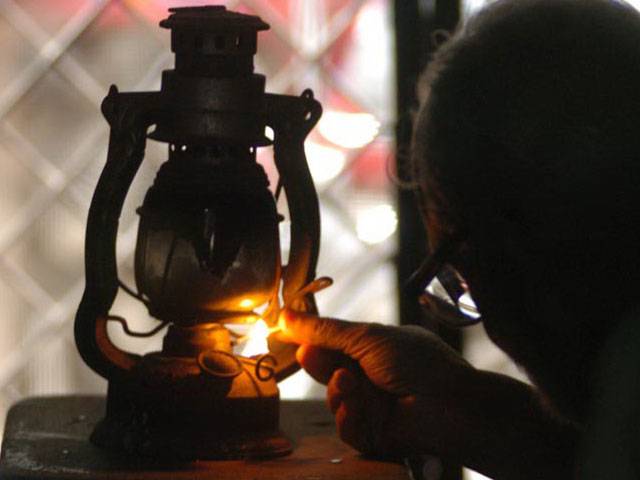LAHORE - Pakistan’s existing power generation capacity is around 23,000MW, more than the peak hours’ demand, but the agonising power outages keep going on because the capacity is not being fully utilised for lack of financial resources. Officials say that around Rs2 billion are needed daily to run the power plants on full capacity.
“Lack of financial resources is the main reason for the ongoing electricity loadshedding in the country, as the total installed generation capacity of Pakistan including all sources is almost 5,000MW in excess of our demand in the current season which is maximum 17,000MW in peak hours,” an official said. The average demand around the year is just 14,500MW, he added.
Energy experts say that factors like incompetency and mismanagement too contribute to the 12-15 hours power shutdowns in most parts of the country, but the most key reason is lack of funds. The say that many of the oil-fired power generation plants are not run on full capacity because there are not enough funds to pay for fuel. Hence, the increased thermal power generation is the major reason for the cost-recovery tariff to continuously increase. Power generation companies are not buying furnace oil from PSO saying they don’t have money for it.
There are four major power producers in country: Water & Power Development Authority), Karachi Electric Supply Company, Independent Power Producers and Pakistan Atomic Energy Commission. According to Wapda officials, electricity produced in Pakistan is from three main sources, i.e, thermal (gas/furnace oil) – 13,637 MW (65% of total), Hydel – 6,654 MW (31% of total) and Nuclear – 812 MW (4% of total). They said that hydel electricity generated by Wapda varies between two extremities –minimum 2,414 MW and maximum of 6,761 MW, depending upon the river flow.
“It is mismanagement, lack of political will and lack of funds, not the insufficient installed generating capacity which is worsening energy problems in Pakistan,” said former Wapda chief Syed Khalid Sajjad. Khalid, who is presently chairman of the Institution of Engineers Pakistan Lahore centre, observed that many public and private power producers have shut down their power plants due to the suspension of fuel supply by Pakistan State Oil, as the oil company is demanding payment of outstanding billions of rupees from the power producers before resuming fuel supply. When asked why government is going for installation of new power plants instead of utilising available ones, he said the present plants are outdated and have become inefficient.
Another Wapda official, who wished not to be named, said that government has to spend around Rs2 billion daily to end loadshedding by generating power through these inefficient plants. During the initial days, the present govt spent almost Rs1 billion daily to ensure regular oil supply for zero loadshedding. Now around Rs300-500 million are being spent on oil purchase to minimise loadshedding, he added. The issue is not only generating power but to also keep the power tariff minimum. He emphasised the need to install new and efficient plants which generate more power on less fuel.
Former Pepco MD Tahir Basharat Cheema observed that in the next 10 years, peak electricity demand is expected to rise by four to five per cent, which is roughly 1,500MW. This dismal energy situation is due to a lopsided energy mix, diminishing indigenous fuel reserves, increasing circular debt and transmission hold-ups. Gas reserves are going to be exhausted while imported oil’s price hikes affect the budget and its constant supply cannot be guaranteed.
Pakistan has the potential to meet these energy challenges through hydel power but there are political and environmental issues in building dams, Tahir said. Rationality demands reduction in reliance on oil and go for alternatives but the development of alternatives does not happen overnight, he added.
Experts were of the view that country will have to rely on imported fuels for the interim period at a huge cost. LNG is difficult to import, using coal has environmental issues, using shale gas also has environmental issues attached with it, and wind power has transmission network challenges, they added.
Former Wapda chairman Shamsul Mulk suggested the government to seek ways to lower the generation cost while increasing the electricity supply through hydel means. He said the government dramatically increased industrial, commercial and bulk buyer tariffs by 50 percent last year, eliminating subsidies totally for these customers.
The government, instead of pursuing thermal power plants should speed up implementation of work on large dams for cheaper electricity, Shamsul Mulk said. He said that further delay in evolving consensus on the big dams including Kalabagh Dam would cost the country and its coming generations dearly. He said stakeholders should show maturity on Kalabagh Dam issue. He said unlike Pakistan, India was building dams at every possible site.
Noted economist Dr Salman Shah said that Pakistan has lost up to10% of its GDP over the last 6 years due to power shortages. Quoting the Planning Commission of Pakistan, GDP suffered a loss of 3 to 4 % due to power and gas shortages last year.
He said that the consumption of energy in Pakistan has a very high impact on the growth rate of GDP (up to 30%). He recommended increasing the generation capacity for a sustainable economic growth based on the rising needs of the industry, agriculture, services and domestic sectors.
Tuesday, August 19, 2025
Lack of funds real reason behind loadshedding

Caption: Lack of funds real reason behind loadshedding
DPM meets Pakistani origin British Members of UK Parliament
8:11 PM | August 18, 2025
NDMA hands over relief supplies to Buner administration
7:26 PM | August 18, 2025
U23 camp shifted from Abbottabad to Islamabad
6:37 PM | August 18, 2025
Mitchell Marsh ready to lead Australia as ODI battle with South Africa begins in Cairns
6:28 PM | August 18, 2025
Attaullah Tarar says national-level efforts underway to tackle flood situation
5:47 PM | August 18, 2025
-
'No talk of President Zardari resigning or COAS seeking Presidency': Naqvi rejects rumours
-
'No talk of President Zardari resigning or COAS seeking Presidency': Naqvi rejects rumours
-
Pilgrims perform final Hajj ritual as Eidul Azha begins amid tight security and heat measures
-
Hajj 2025 sermon: Imam-e-Kaaba prays for Palestine, urges unity and compassion
-
Nearly 2 million Muslim pilgrims ascend Mt Arafat for climax of Hajj pilgrimage
-
How the US repeatedly failed to deliver aid to the people of Gaza
Drowning in Denial
August 17, 2025
A Fragile Peace
August 17, 2025
A Regional Opening
August 17, 2025
Broadening Horizons
August 16, 2025
Code of Care
August 16, 2025
Olympics 2028
August 17, 2025
Alarming Rise in Youth Unemployment
August 17, 2025
Pakistan Turns 78
August 17, 2025
Reviving Night Cricket
August 17, 2025
Unpaid Internships — A Barrier to Talent
August 16, 2025
ePaper - Nawaiwaqt
Nawaiwaqt Group | Copyright © 2025







